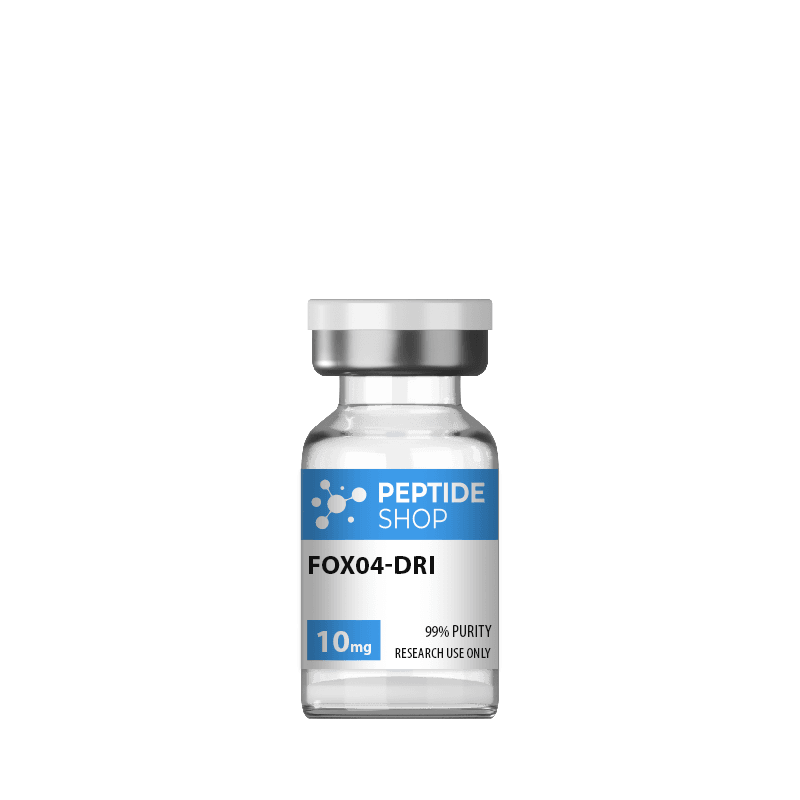Size: 10mg
Contents: FOXO4-DRI (Proxofim)
Form: Lyophilized powder
Purity: >99%

Size: 10mg
Contents: FOXO4-DRI (Proxofim)
Form: Lyophilized powder
Purity: >99%
SHARE:
Products sold on our website are designed for in vitro testing and lab experimentation exclusively.
All the products you see on the website are being sold in a lyophilized powder state (freeze-dried), in a sealed sterile vial; and should be reconstituted.
The product’s label clearly states the amount of product a vial contains; some products are offered in different variations.
The products we are selling come in a sealed vial but require additional lab equipment for proper testing.
FOXO4-DRI is a slightly modified, synthetic version of the regular FOXO4 protein. This change prolongs its half-life and allows it to interact with the standard FOXO4 function.
According to research conducted on animals, FOXO4-DRI can stop normal FOXO4 binding to p53 and, in that way, eliminate senescent cells, improve organ function, and contribute to a younger tissue biological age.
FOX04-DRI affects cell cycle regulation, insulin signaling, and oxidative stress signaling. This cell-penetrating peptide has been shown to selectively induce apoptosis of senescent cells and reverse aging processes in animal test subjects.
This peptide is identical to the protein product of the FOXO4 gene; however, the regular L amino acids have been replaced with D amino acids. The result is that FOXO4-DRI remains in the body longer and for longer periods of time.
FOXO4-DRI interests scientists because of its ability to interfere with normal FOXO4 and because it prevents FOXO4 from binding to p53. This p53 protein is important because it regulates cell cycle progress and programmed cell death.
When FOXO4-DRI binds to p53, it prevents FOXO4 binding and allows p53 to bind to DNA. In turn, this allows the cells to complete the process and die. It seems that FOXO4-DRI only has this effect in senescent cells, which are no longer functional because of aging. FOXO4-DRI targets these dysfunctional cells and stimulates the differentiation and growth of younger and healthier cells. The result is improved biological function and a decrease in biological age.
Molecular Formula: C228H388N86O64
Molecular Weight: 5358.05 g/mol
Other Known Titles: Forkhead box protein O4, Proxofim, FOXO4a, AFX, AFX1, MLLT7
Studies on FOXO4-DRI reveal that while it is not capable of stopping cellular senescence altogether, it holds promise in retarding the process- The peptide acts by inhibiting the interaction between FOXO4 and p53, which is implicated in cell resistance to apoptosis- It has been confirmed that higher levels of FOXO4 in senescent cells suppress their spontaneous clearance.
By suppressing this mechanism, FOXO4-DRI triggers the clearance of senescent cells, which may well trigger cell regeneration. Enhanced body condition, greater kidney function, and increased coat thickness in elderly mice were exhibited by a study on aged mice in 2017, explained by the reduced burden of senescent cells. This effect will likely lower inflammation and reinstate tissue functioning by reducing the deleterious activity of the senescence-associated secretory phenotype. (SASP).
2002 studies show that levels of proteasome enzymes responsible for eliminating damaged or dysfunctional cells also decrease with age. FOXO4 protein regulates these enzymes but is not specifically involved in eliminating the damaged cells. FOXO4-DRI peptide studies indicate that it could aid the natural cleanup process of the body by enhancing the removal of dysfunctional cells, which would help to increase cellular health and function overall.
FOXO4 is closely associated with the insulin and insulin-like growth factor signaling (IIS) pathway that regulates cell response to stress and growth signals. The pathway is crucial in extending lifespan by including stress resistance and improving cell repair mechanisms. FOXO4 can also regulate how nutritional and environmental inputs affect aging, acting as a bridge between external stimuli and the body’s internal mechanisms for longevity- This means that FOXO4 can be a critical element in promoting cellular health and longevity.
Scientific evidence shows that FOXO4 is at the center of cell response to oxidative stress by regulating antioxidant enzyme expression. When cells experience oxidative stress due to excessive free radicals, FOXO4 ensures the activation of protective mechanisms through pathways like p38 AMPK and JNK. This triggers the phosphorylation of FOXO4, which moves to the nucleus to cause the activation of detoxifying enzymes like MnSOD, CAT, and GPX. FOXO4-DRI can inhibit this translocation in senescent cells, encouraging their removal while preserving the health of the rest of the cell.
Moreover, the role of FOXO4 involves inflammation and the tumor necrosis factor-alpha (TNF-a) pathway. This indicates that FOXO4 regulates stress and immunity and has a reinforcing aspect to its action in cellular toughness and longevity.
Research shows that FOXO4-DRI, which interferes with this function in aging cells, can regenerate tissue and reduce inflammation, furthering cellular function.
Experiments show that reduced proteasome enzyme activity with age may be a factor contributing to cognitive loss and neurodegenerative disease. Although the decrease is not directly responsible for the condition, it’s believed to be the cause. FOXO protein levels within the central nervous system are altered in neurodegenerative disease models. This has led to the hypothesis that FOXO4-DRI, by regulating FOXO protein levels, can decelerate or inhibit the onset of NDDs implicated in this process.
Studies examined the ability of FOXO4-DRI in the treatment of age-related hypogonadism with senescent Leydig cells, which are responsible for testosterone secretion. The condition was induced by hydrogen peroxide, and it was found that FOXO4 translocated to the nucleus, which remained protective against apoptosis. When FOXO4-DRI was added, it inhibited FOXO4’s activity so that p53 could bind to DNA and initiate apoptosis. This implies that FOXO4-DRI can help get rid of non-functional Leydig cells, perhaps enhancing testosterone secretion and mitigating age-related endocrine disorders.
Useful links